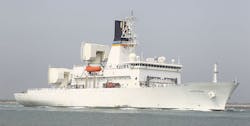Next January, the Cobra Judy Replacement (CJR) program will begin providing the United States government with long-loiter, ballistic-missile data-collection capability in support of international treaty verification. The program recently underwent its first tests against a live rocket launch. From approximately 100 miles off the Florida coast, the powerful X- and S-band radars integrated on-board the USNS Howard O. Lorenzen (T-AGM 25; see photo) successfully acquired and tracked both stages of an Atlas V rocket launched from Cape Canaveral. They also collected all associated data.
With this demonstration, CJR validates its mission capability, advancing the program on schedule toward Initial Operational Capability (IOC). This live-launch exercise follows a series of achievements for the radar suite. Raytheon, prime contractor for the CJR mission equipment and principal, completed the ship-board installation of CJR mission equipment in late 2011 at Kiewit Offshore Services in Corpus Christi, TX. In late 2012, full-power radiation capability was demonstrated for the high-sensitivity shipboard X- and S-band radars. In addition, dual-band satellite acquisition and tracking was successfully performed under the control of the CJR common radar suite controller.
The CJR large-scale, complex dual-band radar suite consists of X- and S-band phased-array sensors, a common radar suite controller, and other related mission equipment. The X- and S-band active phased-array antennas are each approximately four stories tall and weigh more than 500,000 lbs. This program replaces the original Cobra Judy, USNS Observation Island, which has been in service since 1981.
About the Author

Nancy Friedrich
RF Product Marketing Manager for Aerospace Defense, Keysight Technologies
Nancy Friedrich is RF Product Marketing Manager for Aerospace Defense at Keysight Technologies. Nancy Friedrich started a career in engineering media about two decades ago with a stint editing copy and writing news for Electronic Design. A few years later, she began writing full time as technology editor at Wireless Systems Design. In 2005, Nancy was named editor-in-chief of Microwaves & RF, a position she held (along with other positions as group content head) until 2018. Nancy then moved to a position at UBM, where she was editor-in-chief of Design News and content director for tradeshows including DesignCon, ESC, and the Smart Manufacturing shows.
